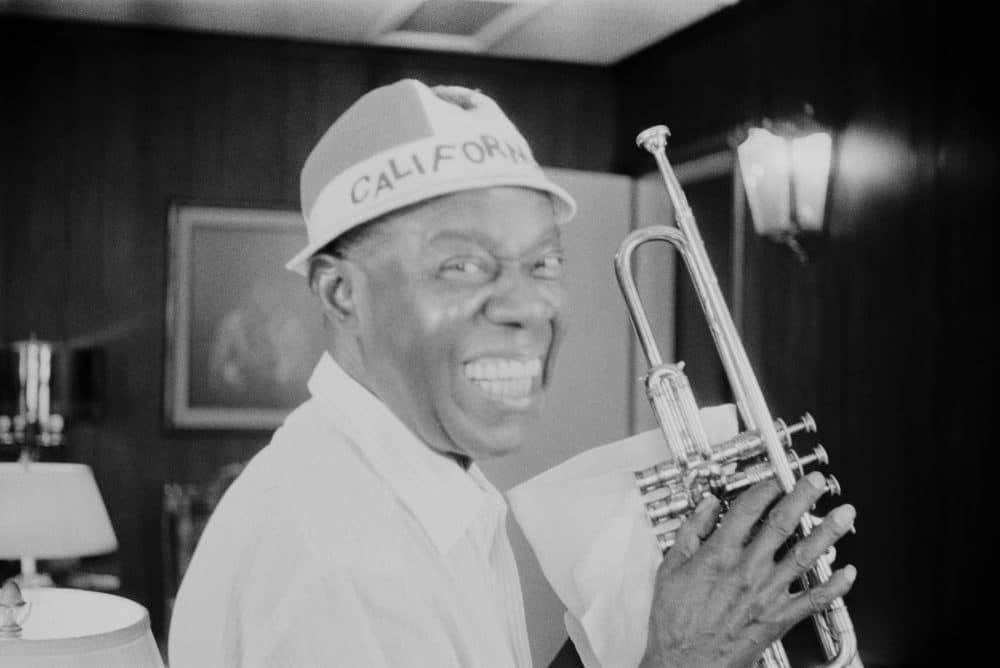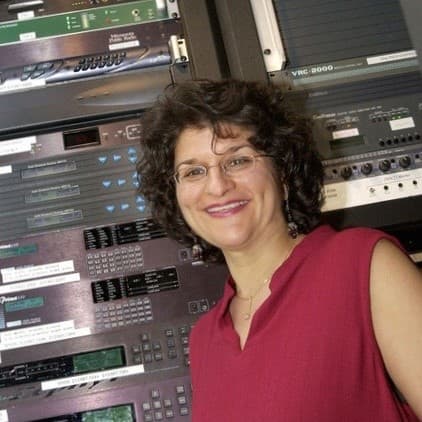Advertisement
Louis Armstrong comes to life in a new way — using his own words — in documentary
Resume
Editor's note: This segment was rebroadcast on Dec. 21, 2023. Click here for that audio.
Hear an extended version of this conversation on our podcast, Here & Now Anytime.
One of the greatest artists of the last century is having a little revival. Louis Armstrong — the gravely voiced singer and maestro of the trumpet — has a new album topping the charts now, more than 50 years after his death. It's a holiday record called "Louis Wishes You A Cool Yule."
And a new documentary called "Louis Armstrong's Black and Blues" depicts the artist as never before — using his own words, taken out of hundreds of hours of recording from his own archive. One of Armstrong’s pastimes was using a reel-to-reel tape machine and recording himself and others for hours.
“I got tapes on my wall, in my den, for 40 years,” Armstrong said. “My life story is right on that wall. And it’s about 20 shelves up to the ceiling.”
Ricky Riccardi, the director of research collections for the Louis Armstrong House Museum in Queens, won a Grammy Award this year for the liner notes he wrote for an Armstrong box set. He has written two books about Armstrong, “Heart Full of Rhythm: The Big Band Years of Louis Armstrong” and “What a Wonderful World: The Magic of Louis Armstrong's Later Years.”
Armstrong in his own words
Armstrong commanded stages around the world, but when he was at his home in Queens, he loved recording himself, often alone and sometimes with others at the house. Riccardi describes the significance of the recordings.
“The tapes allow you to hear Louis Armstrong talking about music, about life, about people, about New Orleans, about racism,” Riccardi says. Armstrong knew he transformed the sound of popular music and that he would be written about in the history books. “So why not be in control of his own story.”
Riccardi says the most surprising thing for most people to hear in the tapes is Armstrong being upset, getting angry or using off-color language. Armstrong was known for working hard to be smiling and warm whenever he was in the spotlight.
“The tapes let you hear those moments where he kind of puts the smile down and just vents,” Riccardi says.
Armstrong’s career stretched for decades when he broke through racial barriers. He lived through social and political change. By the 1960s, many viewed Armstrong as perpetuating a bygone era of forced smiles and minstrel shows. Ozzie Davis speaks of this in the new documentary.
“Most of the fellas I grew up with, myself included, we used to laugh at Louis Armstrong,” Davis says. “Everywhere we looked, there would be old Louis. Sweat popping, eyes bugging, mouth wide open grinning, oh my lord, from ear to ear.” This was years before Davis acknowledges Armstrong was wearing the mask to survive.
Armstrong expressed his feelings in the tape recordings, rather than in public. So, Riccardi acknowledges, the tapes give us a new view of Armstrong.
“It has taken 51 years after he passed away, but now he is speaking for himself,” Riccardi says.
Armstrong’s upbringing
Armstrong grew up in New Orleans. “His childhood is frankly kind of terrifying,” Riccardi says.
His father abandoned the family when he was born and his mother worked as a prostitute. Armstrong had to quit school and start working. He was arrested for the first time at 9 years old for being a “dangerous and suspicious character,” then again on New Year’s Eve, 1913, for firing a gun into the air in celebration.
“To me, it is the greatest arrest in the history of arrests,” Riccardi says, because Armstrong was sent to a juvenile detention center called The Colored Waifs Home for Boys, where he played the cornet and became the leader of the band for the institution.
With music in the air in New Orleans during the birth of jazz, Armstrong fell in love with those sounds.
Making his mark
Armstrong — known as Pops — is a founding father of jazz. An innovator in the art form, he came to prominence in the 1920s. Historians describe him as the first great jazz improviser and soloist.
“There were other soloists before Armstrong, but most of the time they just kind of paraphrase the melody and there wasn’t much improvisation,” Riccardi says.
Armstrong changes everything by playing long solos where he tells a story with improvisation. “His solos have a beginning, middle and an end. And they would usually reach a climax,” Riccardi says. And all different types of musicians started to emulate that over the years.
Armstrong was also an innovator in vocals. He helped create scat singing and put swing into popular singing. Historians say you could draw a line before Armstrong and after in terms of vocal style.
“When you listen to American pop singing in the ‘20s it’s very corny. It’s very stiff,” Riccardi says. Armstrong then “kind of busts the door down. Everything he does swings."
‘Wonderful World’
Armstrong may be best known now for his song “What a Wonderful World.” It is one of his last recordings, and it is a song of hope, peace and simple joys. Riccardi says Armstrong viewed the song as an anthem to his neighborhood in Corona, Queens.
“I saw three generations grow up on that block,” Armstrong said. “With their children and grandchildren, they come back to see Uncle Satchmo and Aunt Lucille.” He saidwhen he sang the song, he saw the faces of all of those children, “and it is a wonderful world.” He acknowledged, “We have a few jerks. Always have that. But it’s still a wonderful world.”
Upon Armstrong’s death in 1971, CBS News anchor Walter Cronkite hosted a documentary tribute to the master musician. Cronkite puts Armstrong’s life into historical perspective.
“While we can only guess how Bethoveen played the piano or Mozart conducted an orchestra, the sounds of Louis — singing, playing or just plain talking — will live as long as there is anyone to listen,” Cronkite says.
“He is the entire 20th century wrapped up into one person,” Ricky Riccardi says, summing up Armstrong’s legacy.
Born in 1901, Armstrong lived through world wars, the Great Depression and the civil rights struggle. And he became an international star across the entire media landscape.
“He conquers film, he conquers television, he conquers radio, he conquers the stage, he conquers records. And he’s got the rags to riches upbringing,” Riccardi says. “It’s all there in one man. And his legacy is now stronger than ever.”
Shirley Jahad produced and edited this interview for broadcast with Catherine Welch. Jahad also adapted it for the web.
This segment aired on December 16, 2022.





